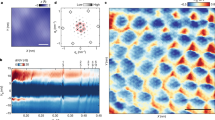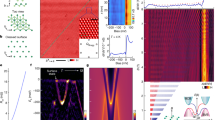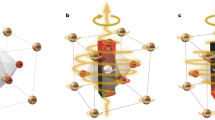Abstract
Spin liquid ground states are predicted to arise within several distinct scenarios in condensed matter physics. The observation of these disordered magnetic states is particularly pervasive among a class of materials known as frustrated magnets, in which the competition between various magnetic exchange interactions prevents the system from adopting long-range magnetic order at low temperatures. Spin liquids continue to be of great interest due to their exotic nature and the possibility that they may support fractionalized excitations, such as Majorana fermions. Systems that allow for such phenomena are not only fascinating from a fundamental perspective but may also be practically significant in future technologies based on quantum computation. Here we show that the underlying antiferromagnetic sublattice in TbInO3 can undergo a crystal field-induced distortion of its buckled triangular arrangement to one based on a honeycomb. The absence of a conventional magnetic ordering transition at the lowest measurable temperatures indicates that another critical mechanism must govern in the ground-state selection of TbInO3. We suggest that anisotropic exchange interactions—mediated through strong spin–orbit coupling on the emergent honeycomb lattice of TbInO3—give rise to a highly frustrated spin liquid.
This is a preview of subscription content, access via your institution
Access options
Access Nature and 54 other Nature Portfolio journals
Get Nature+, our best-value online-access subscription
$29.99 / 30 days
cancel any time
Subscribe to this journal
Receive 12 print issues and online access
$209.00 per year
only $17.42 per issue
Buy this article
- Purchase on Springer Link
- Instant access to full article PDF
Prices may be subject to local taxes which are calculated during checkout





Similar content being viewed by others
Data availability
Raw powder neutron diffraction54 and muon spin relaxation data55 were collected on the HRPD, MuSR and EMu instruments at ISIS Neutron and Muon Facility and Rutherford Appleton Laboratory, UK, respectively. Powder inelastic neutron scattering data were collected on the SEQUOIA and CNCS instruments at the Spallation Neutron Source, Oak Ridge National Laboratory, USA56. All other raw and derived data used to support the findings of this study are available from the authors on request.
References
Balents, L. Spin liquids in frustrated magnets. Nature 464, 199–208 (2010).
Savary, L. & Balents, L. Quantum spin liquids. Rep. Prog. Phys. 80, 016502 (2017).
Yan, S. et al. Spin liquid ground state of the S=½ kagome Heisenberg model. Science 332, 1173–1176 (2011).
Fu, M. et al. Evidence for a gapped spin-liquid ground state in a kagome Heisenberg antiferromagnet. Science 350, 655–658 (2015).
Reger, J. D. et al. Monte Carlo simulations of the spin-½ Heisenberg antiferromagnet in two dimensions. J. Phys. Condens. Matter 1, 1855–1865 (1989).
Jackeli, G. & Khaliullin, G. Mott insulators in the strong spin–orbit coupling limit: from Heisenberg to a quantum compass and Kitaev models. Phys. Rev. Lett. 102, 017205 (2009).
Chaloupka, J. et al. Kitaev–Heisenberg model on a honeycomb lattice: possible exotic phases in iridium oxides A 2IrO3. Phys. Rev. Lett. 105, 027204 (2010).
Banerjee, A. et al. Proximate Kitaev quantum spin liquid behaviour in a honeycomb magnet. Nat. Mater. 15, 733–740 (2016).
Sandilands, L. J. et al. Spin–orbit excitations and electronic structure of the putative Kitaev magnet α-RuCl3. Phys. Rev. B 93, 075144 (2016).
Shankar, V. V. et al. Kitaev magnetism in honeycomb α-RuCl3 with intermediate spin–orbit coupling. Phys. Rev. B 91, 241110 (2015).
Sandilands, L. J. et al. Scattering continuum and possible fractionalized excitations in α-RuCl3. Phys. Rev. Lett. 114, 147201 (2015).
Sears, J. A. et al. Magnetic order in α-RuCl3: a honeycomb-lattice quantum magnet with strong spin–orbit coupling. Phys. Rev. B 91, 144420 (2015).
Plumb, K. W. et al. α-RuCl3: a spin–orbit assisted Mott insulator on a honeycomb lattice. Phys. Rev. B 90, 041112(R) (2014).
Williams, S. C. et al. Incommensurate counterrotating magnetic order stabilized by Kitaev interactions in the layered honeycomb α-Li2IrO3. Phys. Rev. B 93, 195158 (2016).
Chun, S. H. et al. Direct evidence for dominant bond-directional interactions in a honeycomb lattice iridate Na2IrO3. Nat. Phys. 11, 462–466 (2015).
Choi, S. K. et al. Spin waves and revised crystal structure of honeycomb iridate Na2IrO3. Phys. Rev. Lett. 108, 127204 (2012).
Ye, F. et al. Direct evidence of a zigzag spin-chain structure in the honeycomb lattice: a neutron and X-ray diffraction investigation of single-crystal Na2IrO3. Phys. Rev. B 85, 180403(R) (2012).
Liu, X. et al. Long-range magnetic ordering in Na2IrO3. Phys. Rev. B 83, 220403(R) (2011).
Singh, Y. & Gegenwart, P. Antiferromagnetic Mott insulating state in single crystals of the honeycomb lattice material Na2IrO3. Phys. Rev. B 82, 064412 (2010).
Bramwell, S. T. & Gingras, M. J. P. Spin ice state in frustrated magnetic pyrochlore materials. Science 294, 1495–1501 (2001).
Castelnovo, C. et al. Magnetic monopoles in spin ice. Nature 451, 42–45 (2008).
Molavian, H. R. et al. Dynamically induced frustration as a route to a quantum spin ice state in Tb2Ti2O7 via virtual crystal field excitations and quantum many-body effects. Phys. Rev. Lett. 98, 157204 (2007).
Ross, K. A. et al. Quantum excitations in quantum spin ice. Phys. Rev. X 1, 021002 (2011).
Princep, A. J. et al. Crystal-field states of Pr3+ in the candidate quantum spin ice Pr2Sn2O7. Phys. Rev. B 88, 104421 (2013).
Li, Y. et al. Rare-earth triangular lattice spin liquid: a single-crystal study of YbMgGaO4. Phys. Rev. Lett. 115, 167203 (2015).
Paddison, J. A. M. et al. Continuous excitations of the triangular-lattice quantum spin liquid YbMgGaO4. Nat. Phys. 13, 117–122 (2017).
Mydosh, J. Disordered magnetism and spin glasses. J. Magn. Magn. Mater. 157, 606–610 (1996).
Aczel, A. A. et al. Spin-liquid ground state in the frustrated J 1−J 2 zigzag chain system BaTb2O4. Phys. Rev. B 92, 041110(R) (2015).
Pratt, F. L. Field dependence of μSR signals in a polycrystalline magnet. J. Phys. Condens. Matter 19, 456207 (2007).
Uemura, Y. J. et al. Muon-spin relaxation in AuFe and CuMn spin glasses. Phys. Rev. B 31, 546–563 (1985).
Dunsiger, S. R. et al. Muon spin relaxation investigation of the spin dynamics of geometrically frustrated antiferromagnets Y2Mo2O7 and Tb2Mo2O7. Phys. Rev. B 54, 9019–9022 (1996).
Gardner, J. S. et al. Cooperative paramagnetism in the geometrically frustrated pyrochlore antiferromagnet Tb2Ti2O7. Phys. Rev. Lett. 82, 1012–1015 (1999).
Baker, P. J. et al. Muon-spin relaxation measurements on the dimerized spin-1/2 chains NaTiSi2O6 and TiOCl. Phys. Rev. B 75, 094404 (2007).
Gardner, J. S. et al. Neutron scattering studies of the cooperative paramagnet pyrochlore Tb2Ti2O7. Phys. Rev. B 64, 224416 (2001).
Wills, A. S. et al. Short-range order in the topological spin glass (D3O)Fe3(SO4)2(OD)6 using xyz polarized neutron diffraction. Phys. Rev. B 64, 094436 (2001).
Chen, G. ‘Magnetic monopole’ condensation of the pyrochlore ice U(1) quantum spin liquid: application to Pr2Ir2O7 and Yb2Ti2O7. Phys. Rev. B 94, 205107 (2016).
Chen, G. Dirac’s ‘magnetic monopoles’ in pyrochlore ice U(1) spin liquids: spectrum and classification. Phys. Rev. B 96, 195127 (2017).
Mermin, N. D. & Wagner, H. Absence of ferromagnetism or antiferromagnetism in one- or two-dimensional isotropic Heisenberg models. Phys. Rev. Lett. 17, 1133–1136 (1966).
Regnault, L. P. et al. Magnetic properties of the layered nickel compounds BaNi2(PO4)2 and BaNi2(AsO4)2. J. Magn. Magn. Mater. 15-18, 1021–1022 (1980).
Rogado, N. et al. BaNi2V2O8: a two-dimensional honeycomb antiferromagnet. Phys. Rev. B 65, 144443 (2002).
Kitaev, A. Anyons in an exactly solved model and beyond. Ann. Phys. 321, 2–111 (2006).
Li, F.-Y. et al. Kitaev materials beyond iridates: order by quantum disorder and Weyl magnons in rare-earth double perovskites. Phys. Rev. B 95, 085132 (2017).
Savary, L. et al. Order by quantum disorder in Er2Ti2O7. Phys. Rev. Lett. 109, 167201 (2012).
Fritsch, K. et al. Antiferromagnetic spin ice correlations at (½, ½, ½) in the ground state of the pyrochlore magnet Tb2Ti2O7. Phys. Rev. B 87, 094410 (2013).
Curnoe, S. H. Effective spin-1/2 exchange model for Tb2Ti2O7. Phys. Rev. B 88, 014429 (2013).
Takatsu, H. et al. Quadrupolar order in the frustrated pyrochlore magnet Tb2Ti2O7. J. Phys. Conf. Ser. 683, 012022 (2016).
Jang, S. H.et al. Antiferromagnetic Kitaev interaction in f-electron based honeycomb magnets. Preprint at https://arxiv.org/abs/1807.01443 (2018).
Pistorius, C. W. F. T. & Kruger, G. J. Stability and structure of noncentrosymmetric hexagonal LnInO3 (Ln = Eu, Gd, Tb, Dy, Ho, Y). J. Inorg. Nucl. Chem. 38, 1471–1475 (1976).
Sears, V. F. Neutron scattering lengths and cross sections. Neutron News 3, 26–37 (1992).
Larson, A. C. and Von Dreele, R. V. General Structure Analysis System, report no. LAUR 86-748 (Los Alamos National Laboratory, 1994).
Granroth, G. E. et al. SEQUOIA: a newly operating chopper spectrometer at the SNS. J. Phys. Conf. Ser. 251, 012058 (2010).
Ehlers, G., Podlesnyak, A. A. & Kolesnikov, A. I. The cold neutron chopper spectrometer at the Spallation Neutron Source—a review of the first 8 years of operation. Rev. Sci. Instrum. 87, 093902 (2016).
Azuah, R. T. et al. DAVE: a comprehensive software suite for the reduction, visualization, and analysis of low-energy neutron spectroscopic data. J. Res. Natl Inst. Stan. Technol. 114, 341–358 (2009).
Clark, L. et al. Low Temperature Structural Investigation of the Triangular Lattice Material TbInO 3 https://doi.org/10.5286/ISIS.E.58450984 (Science and Technology Facilities Council, 2015).
Clark, L. et al. A muSR Investigation of the Magnetic Ground State and Spin Dynamics in the Triangular Antiferromagnet TbInO 3 https://doi.org/10.5286/ISIS.E.79175145 (Science and Technology Facilities Council, 2016).
Sala, G. et al. TbInO 3 reduced neutron spectroscopy data from SNS on the CNCS and SEQUOIA instruments https://doi.org/10.13139/OLCF/1483946 (Oak Ridge National Laboratory, 2015).
Acknowledgements
Work at McMaster University was supported by NSERC of Canada. Research at Oak Ridge National Laboratory’s Spallation Neutron Source was supported by the Scientific User Facilities Division, Office of Basic Energy Sciences, US Department of Energy. Work at ISIS was supported by the Science and Technology Facilities Council. Work at Rutgers University was supported by the DOE under grant no. DOE: DE-FG02–07ER46382. The authors thank A. Aczel, P. Baker, G. Chen and M. Gingras for helpful and insightful discussions during preparation of this manuscript.
Author information
Authors and Affiliations
Contributions
B.D.G. and S.-W.C. conceived and supervised the project. X.W., X.X. and Y.L. prepared samples and J.K. performed single-crystal magnetic susceptibility measurements. L.C. performed and analysed powder magnetic susceptibility measurements. L.C. and K.S.K. performed high-resolution powder neutron diffraction measurements and L.C. carried out Rietveld analysis of the data. L.C. and M.T.F.T. performed muon spectroscopy measurements and L.C. analysed the data. G.S., D.D.M. and M.B.S. performed the inelastic neutron scattering measurements and G.S. and L.C. analysed the data with guidance from B.D.G. G.S. performed the crystal field calculations and analysis with guidance from B.D.G. L.C. and B.D.G. prepared figures and wrote the paper.
Corresponding authors
Ethics declarations
Competing interests
The authors declare no competing interests.
Additional information
Publisher’s note: Springer Nature remains neutral with regard to jurisdictional claims in published maps and institutional affiliations.
Supplementary information
Supplementary Information
Supplementary Text, Supplementary Tables 1–2 and Supplementary Figures 1–4.
Rights and permissions
About this article
Cite this article
Clark, L., Sala, G., Maharaj, D.D. et al. Two-dimensional spin liquid behaviour in the triangular-honeycomb antiferromagnet TbInO3. Nat. Phys. 15, 262–268 (2019). https://doi.org/10.1038/s41567-018-0407-2
Received:
Accepted:
Published:
Issue Date:
DOI: https://doi.org/10.1038/s41567-018-0407-2
This article is cited by
-
Candidate spin-liquid ground state in CsNdSe2 with an effective spin-1/2 triangular lattice
Communications Materials (2024)
-
Classical spin liquid state in a rhombic lattice metal-organic framework
Nano Research (2024)
-
Unconventional room-temperature carriers in the triangular-lattice Mott insulator TbInO3
Nature Physics (2023)
-
The Ising triangular-lattice antiferromagnet neodymium heptatantalate as a quantum spin liquid candidate
Nature Materials (2022)
-
Magnetic properties of new layered compounds LaM1/3Sb5/3O6, M = Co, Ni, and Cu, with a honeycomb structure
Russian Chemical Bulletin (2021)



